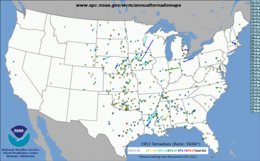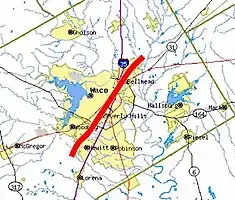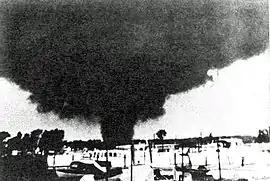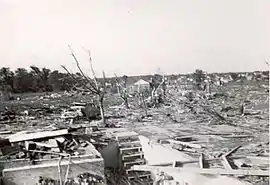Tornadoes of 1953
This page documents the tornadoes and tornado outbreaks of 1953, primarily in the United States. Most tornadoes form in the U.S., although some events may take place internationally. Tornado statistics for older years like this often appear significantly lower than modern years due to fewer reports or confirmed tornadoes. This was the first year to record an F5 tornado in the US.
 Tornado tracks of 1953. | |
| Timespan | 1953 |
|---|---|
| Maximum rated tornado | F5 tornado
|
| Tornadoes in U.S. | 421[1] |
| Damage (U.S.) | Unknown |
| Fatalities (U.S.) | 523 |
| Fatalities (worldwide) | >529 |
Events
Despite not many tornadoes being documented, 1953 was an extremely deadly season. The first six months of the year generated several large outbreaks and outbreak sequences that killed over 400 people. Activity abruptly slowed after that before another outbreak sequence in December killed 49. Many of fatalities were caused by the unusually large number of violent tornadoes that were recorded that year. This included five F5 tornadoes, the first F5 tornadoes recorded in the US tornado database created in 1950. In all, there were 523 tornado-related fatalities in the US alone in 1953, the most since 1925. This high a death toll would not be repeated until 2011. There were 5,131 injuries recorded throughout the year as well. 1953 is also the only year since 1950 to have three tornadoes kill over 90 people and to have two tornadoes kill over 110. On a positive note, major changes were made to improve both the warning and radar systems. These changes were successful and since 1953, only one tornado, the 2011 Joplin tornado, has killed more than 100 people.[1]
United States yearly total
| FU | F0 | F1 | F2 | F3 | F4 | F5 | Total |
|---|---|---|---|---|---|---|---|
| 0 | 66 | 159 | 134 | 40 | 17 | 5 | 421 |
January
There were 14 tornadoes confirmed in the US in January.[1]
February
There were 16 tornadoes confirmed in the US in February.[1]
February 6
An isolated, but large F3 tornado tore through Baptist, Louisiana before striking the north side of Hammond and Southeastern Louisiana University. Two people were killed and 21 others were injured.[1]
February 19–20
| FU | F0 | F1 | F2 | F3 | F4 | F5 |
|---|---|---|---|---|---|---|
| 0 | 0 | 9 | 5 | 1 | 0 | 0 |
An outbreak of 15 tornadoes struck Texas, Oklahoma, Arkansas, Mississippi, and Alabama. Seven F1 tornadoes touched down across the two Plains states on February 19 before the strong tornadoes struck the other states the next day. A large, .5 mile wide F2 tornado hit the north side of Pontotoc, Mississippi before striking Endville, injuring one person. Later, a brief, but strong F3 tornado killed one and injured eight south of Tuscumbia, Alabama. The outbreak ended with an F2 tornado hitting the southwest side of Hartselle, Alabama, injuring six. Overall, the tornadoes killed one and injured 20.[1]
March
There were 40 tornadoes confirmed in the US in March.[1]
March 12–15
| FU | F0 | F1 | F2 | F3 | F4 | F5 |
|---|---|---|---|---|---|---|
| 0 | 1 | 4 | 11 | 6 | 1 | 0 |
The first major outbreak of the year struck areas from the Great Plains to the Ohio Valley.[2] The worst tornado occurred on March 13, when an F4 tornado struck the towns of Jud, O'Brien, and Knox City, Texas, killing 17 and injuring 25.[3][4] The same day, a destructive F3 tornado killed one and injured eight in Bradley, Oklahoma.[5] A long-tracked F3 tornado family passed over Lake Murray State Park and struck Earl, Oklahoma, killing two and injuring 11.[6][7] Several strong, destructive tornadoes touched down in Arkansas overnight into March 14 before another deadly F2 tornado killed one in Altitude, Mississippi.[2][8][9] The outbreak ended the next day after an isolated, narrow but intense, long-track F3 tornado ripped through Northern Wilson, Macclesfield, and Crisp, North Carolina, injuring one.[10][11][12] Overall, the outbreak produced at least 23 tornadoes, killed 21 people, and injured 72 others.[2]
March 21–22
| FU | F0 | F1 | F2 | F3 | F4 | F5 |
|---|---|---|---|---|---|---|
| 0 | 0 | 4 | 5 | 1 | 0 | 0 |
An outbreak of 10 tornadoes struck the Midwest and the Mississippi Valley. On March 21, a large F3 tornado moved through Bancroft, Iowa, although there were no casualties. This was not the case in Minnesota, where a brief but strong F2 tornado killed one and injured three east-northeast of St. Cloud. The next day, an extremely long-tracked F2 tornado traveled 234.7 miles through Louisiana and Mississippi (although this was more than likely a tornado family rather than just a single tornado). The tornado passed near the cities of Alexandria, Louisiana, Vicksburg, Mississippi, and Greenville, Mississippi, killing two people and injuring 22 others. Overall, the tornadoes killed three and injured 28.[1]
April
There were 47 tornadoes confirmed in the US in April.[1]
April 5 (Bermuda)
| FU | F0 | F1 | F2 | F3 | F4 | F5 |
|---|---|---|---|---|---|---|
| 4 | 0 | 0 | 0 | 0 | 0 | 0 |
An outbreak of four tornadoes struck Bermuda, killing one person and injuring nine others.[13]
April 9
| FU | F0 | F1 | F2 | F3 | F4 | F5 |
|---|---|---|---|---|---|---|
| 0 | 0 | 1 | 1 | 1 | 0 | 0 |
A series of tornadoes struck Kansas, Illinois, and Indiana. In Kansas, a brief F1 tornado touched down north-northwest of Dighton with no casualties. Later, in Illinois, an F2 tornado hit the northwest side of Lincoln, injuring three. The worst tornado was a large and extremely long-tracked F3 tornado that traveled 156.7 miles (252.2 km) through Illinois and Indiana (although this was also likely a tornado family). The 750-yard-wide (690 m) tornado killed three and injured 22 as it traveled eastward from Champaign, Illinois to areas north of Indianapolis and Muncie, Indiana. In the end, the three tornadoes killed three and injured 25.[1]
April 18
| FU | F0 | F1 | F2 | F3 | F4 | F5 |
|---|---|---|---|---|---|---|
| 0 | 0 | 0 | 2 | 1 | 0 | 0 |
Three strong and destructive tornadoes struck Alabama and Georgia. Most of casualties came from a large, long-tracked F3 tornado that traveled 39.8 miles through Alabama into Georgia. The 400 yard tornado touched down in Lochapoka, Alabama and moved southeast through Lee County before moving into Georgia and striking Bibb City on the north side of Columbus. The twister killed eight people and injured a staggering 495. Three people were injured by two additional F2 tornadoes that touched down that day. In the end, the tornadoes killed eight people and injured 498 others.[1] Some of the same areas took out by the F3 tornado were hit again by an even stronger and deadlier EF4 tornado on March 3, 2019.[14][15]
April 23–24
| FU | F0 | F1 | F2 | F3 | F4 | F5 |
|---|---|---|---|---|---|---|
| 0 | 0 | 2 | 5 | 1 | 0 | 0 |
Yet another destructive and deadly tornado outbreak hit Oklahoma, Arkansas, Mississippi, and Iowa with all the casualties occurring in Oklahoma. On April 23, an F2 tornado killed one and injured four northeast of Weleetka, Oklahoma. A brief, but large, .5-mile-wide (0.80 km) F3 tornado touched down right over Alma, Arkansas, although there were no casualties. Later, another F2 tornado struck Idabel, Oklahoma, injuring one. The worst tornado was a small, but deadly F2 tornado that hit the southeast side of Eagletown, Oklahoma, killing one and injuring 14. More tornado activity was confirmed the next day, including a long-tracked F2 tornado that touched down in Fayette, Mississippi and struck Downtown Jackson along its 96.7-mile-path (155.6 km), although there no casualties reported. Overall, eight tornadoes touched down, killing two people and injuring 16 others.[1]
April 27
A rare F2 tornado touched down briefly on the north side of Modesto, California, although there were no casualties.[1]
April 28–May 2
| FU | F0 | F1 | F2 | F3 | F4 | F5 |
|---|---|---|---|---|---|---|
| 0 | 3 | 6 | 7 | 3 | 5 | 0 |
A major tornado outbreak sequence struck areas from the Great Plains to the Southeast, producing 24 tornadoes, including five F4 tornadoes. April 28 saw a deadly, mile wide F4 tornado strike northwest of San Antonio in the town of Helotes, Texas, killing two and injuring 15. The worst event occurred on April 30, when a 333 yd (304 m) wide F4 tornado killed 18 and injured 300 in Warner Robins, Georgia, despite being on the ground for only a 1.0 mi (1.6 km). May 1 saw two F4 tornadoes in Alabama cause nine deaths and 15 injuries. The outbreak ended on May 2, but not before another F4 tornado killed four and injured eight northeast of Decatur, Tennessee. Overall, the outbreak killed 36 people and injured 361.[1]
May
There were 94 tornadoes confirmed in the US in May.[1]
May 9–11

| FU | F0 | F1 | F2 | F3 | F4 | F5 |
|---|---|---|---|---|---|---|
| 0 | 1 | 15 | 8 | 4 | 4 | 1 |
A violent outbreak of at least 33 tornadoes struck the Great Plains and the Upper Mississippi Valley in Early-May just a week after the previous outbreak ended. On May 9, a large, long-tracked, .5 mile wide F3 tornado hit Milligan, Friend, and Milford, Nebraska, killing five and injuring 82. May 10 saw three F4 tornadoes strike Iowa. The third F4 twister ended up being an extremely long-tracked tornado family that moved through Iowa, Minnesota, and Wisconsin on a 162 mi (261 km) path. It struck the towns of Chester, Iowa, Wykoff, Dover, St. Charles, Crystal Spring and Minneiska, Minnesota, and Cochrane, Waumandee, Lookout, Strum, Foster, Ludington, Edson, Stanley, Brownsville, and Gilman, Taylor County, Wisconsin. This family consisted of at least five tornadoes, killing two and injuring 24. Tornado activity on May 11 began with a .5 mile wide F4 tornado striking areas between Grape Creek and San Angelo, Texas, killing 13 and injuring 159. Later that day, the first officially rated F5 tornado in US history obliterated Downtown Waco, destroying or collapsing many of the structures and tossing numerous vehicles. 114 were killed and 597 were injured, making it the deadliest tornado in Texas history. Overall, the outbreak killed 144 and injured 895.[16]
May 16–19
| FU | F0 | F1 | F2 | F3 | F4 | F5 |
|---|---|---|---|---|---|---|
| 0 | 4 | 4 | 7 | 2 | 0 | 0 |
Widely scattered tornadoes struck numerous areas across the US. On May 16, an F3 tornado struck Cooper, Texas, killing one and injuring eight. This tornado was unusual because it moved in west-northwest direction. On May 17, a long-tracked F3 tornado moved through Rayville, Epps, and Wilman, Louisiana, injuring 17. On May 19, another rare F2 tornado struck California. It moved through northeast side of Orland, although there were no casualties. Overall, the 17 tornadoes during the period killed one and injured 30.[1]
May 20–21 (United States and Canada)

| FU | F0 | F1 | F2 | F3 | F4 | F5 |
|---|---|---|---|---|---|---|
| 0 | 0 | 0 | 0 | 2 | 1 | 0 |
Three intense tornadoes struck Iowa, Michigan, and Ontario over the course of two days. On May 20, two long-tracked F3 tornadoes struck Iowa, killing one and injuring seven. The next day, a violent long-tracked F4 tornado struck the cities of Port Huron, Michigan and Sarnia, Ontario, killing seven and injured over 68. At least nine more tornadoes were reported in Ontario, but none were confirmed. Overall, the outbreak killed eight and injured 75.[1]
May 29
| FU | F0 | F1 | F2 | F3 | F4 | F5 |
|---|---|---|---|---|---|---|
| 0 | 0 | 3 | 5 | 0 | 0 | 1 |
An outbreak of nine tornadoes struck the Great Plains. The worst tornado was a 600 yd (550 m) wide F5 tornado that struck Fort Rice, North Dakota (although some experts like Grazulis dispute this, claiming that it was an F4 tornado). The tornado completely leveled a church and threw car parts up to .5 miles (0.80 km). In the end, 20 of the 22 injuries and both deaths from the outbreak came from this tornado.[17]
June
There were 110 tornadoes confirmed in the US in June.[1]
June 7–9
| FU | F0 | F1 | F2 | F3 | F4 | F5 |
|---|---|---|---|---|---|---|
| 0 | 14 | 10 | 13 | 7 | 5 | 1 |
Just under one month after the deadly Waco outbreak, an even deadlier tornado outbreak sequence struck the Great Plains, Great Lakes, and even New England in Early-June. It started on June 7, when a tornado outbreak spawned 34 tornadoes across the Great Plains. The strongest and only fatal tornado of the day was a .25 mi (0.40 km) wide F4 tornado that struck areas near Arcadia, Nebraska. It injured no one, but killed 11, including an entire family of 10 at a swept away farm. In Iowa, a 200 yd (180 m) wide F2 tornado traveled 116 mi (187 km), destroying several barns, but causing no casualties. In all, tornadoes on June 7 killed 11 and injured 19.[1]

June 8 had way fewer tornadoes than the previous day, but the nine tornadoes that hit Michigan and Ohio that day were way stronger and deadlier. The first fatal tornado of the day was an F4 tornado that struck Temperance, Michigan before moving through areas south of Erie, killing four and injuring 17. The only Ohio tornado of the day then touched down and became a long-tracked F4 tornado family (which may have reached F5 intensity in Cygnet, Jerry City, or both) that struck the cities of Fremont, Sandusky, Elyria, and even Western Cleveland, causing catastrophic damage, killing 17, and injuring 379 on its 118 mi (190 km) path.[18] Back in Michigan, an F3 tornado killed one and injured five between Sharon Hollow and Ann Arbor. At the same time, another F3 tornado struck Highland Charter Township, injuring 11. A massive, 833 yd (762 m) wide F2 tornado then hit the north side of Oscoda, killing four and injuring 13. An F3 tornado then touched down and caused considerable damage on the south side of Spruce, although it was the only significant (F2+) tornado of the day to not cause casualties. The strongest and deadliest tornado then touched down and struck the northern suburbs of Flint, Michigan in the community of Beecher at F5 intensity with little to no warning. The large 833 yd (762 m) wide tornado obliterated and swept away many homes and a staggering 113 people lost their lives in the town alone. The tornado killed a total of 116 people and injured 844 others. After that tornado lifted, the same cell produced the final tornado of the day. The large, long tracked, 833 yd (762 m) wide F4 tornado carved a 33.8 mi (54.4 km) path of destruction through rural Lapeer and St. Clair Counties, injuring 23, thus becoming the only violent tornado of the outbreak sequence to not cause any fatalities. In all, 12 tornadoes touched down on June 8, killing 142 people and injuring 1,293 others.[1]

June 9 produced a small, but unusually intense outbreak of four tornadoes in New England. Despite knowing that there was the possibility of tornadoes that day, the National Weather Service in Boston had only issued a Severe Thunderstorm Watch, fearing that the mention of a tornado threat would cause widespread panic.[19][20] This proved to be a fatal mistake when a violent, 900 yd (820 m) wide F4 tornado struck Worcester, Massachusetts with no warning. The hardest hit area was Assumption College (building is now the Quinsigamond Community College), and its surrounding neighborhoods, where 42 people were killed. The college building was reduced by three floors and numerous homes were obliterated, leaving some to speculate that the tornado reached F5 intensity in this area. A tornado warning was not issued until the tornado was lifting 80 minutes after it had touched down. By then, 94 people were dead and 1,228 others were injured. In the end, the tornadoes of June 9 in New Hampshire and Massachusetts killed 94 and injured 1,250.[1]
Overall, at least 50 tornadoes touched down, including six violent tornadoes. The outbreak injured 2,562 people while killing 247, accounting for a little over 47% of the fatalities from 1953 alone. Many revolutionary changes were made to improve both the warning and radar systems as a result of this outbreak.[21]
June 27
| FU | F0 | F1 | F2 | F3 | F4 | F5 |
|---|---|---|---|---|---|---|
| 0 | 0 | 2 | 2 | 0 | 0 | 1 |
A small, but damaging outbreak of five tornadoes struck Iowa and North Dakota. The worst tornado was a brief, but violent 100 yd (91 m) wide F5 tornado that destroyed four farms east of Anita, Iowa, with virtually nothing left at one of them. Heavy machinery was thrown hundreds of feet, and boards were driven into trees. One person was killed and two others were injured. The tornado track was only 0.1 mi (0.16 km), the shortest track of any F5/EF5 tornado in the US since 1950.[22] As a whole, the outbreak killed one and injured five.[23]
July
There were 32 tornadoes confirmed in the US in July.[1]
August
There were 24 tornadoes confirmed in the US in August.[1]
September
There were 5 tornadoes confirmed in the US in September.[1]
October
There were 6 tornadoes confirmed in the US in October.[1]
November
There were 12 tornadoes confirmed in the US in November.[1]
December
There were 21 tornadoes confirmed in the US in December.[1]
December 1–6

| FU | F0 | F1 | F2 | F3 | F4 | F5 |
|---|---|---|---|---|---|---|
| 0 | 0 | 4 | 10 | 3 | 1 | 1 |
Although usually a quiet month, the first six days of the December were extremely destructive and deadly as a series of single damaging tornado days and small outbreaks combined into a tornado outbreak sequence of 19 tornadoes across the South. On December 2, a brief, but strong F2 tornado killed two and injured five west of Navasota, Texas. The next day, a 300 yd (270 m) wide, violent F4 tornado tracked 85.5 mi (137.6 km) through four Parishes in Louisiana. Passing northwest of Alexandria, the tornado killed nine and injured 50. The worst day of the outbreak sequence occurred on December 5, when four strong to violent tornadoes struck the Lower Mississippi Valley. The strongest and deadliest tornado was a 880 yd (800 m) wide violent F5 tornado that struck Vicksburg, Mississippi. Many buildings were leveled, although most were frail in nature, causing some experts to rate this as an F4 tornado. Regardless, 38 people were killed and 270 others were injured along the 9 mi (14 km) path of destruction. In fact, tornadoes on this day killed 38 and injured 292 people alone. In the end, the outbreak sequence killed 49 and injured 404.[1]
See also
- Tornado
- List of tornado outbreaks
- List of F5 and EF5 tornadoes
- List of North American tornadoes and tornado outbreaks
- List of 21st-century Canadian tornadoes and tornado outbreaks
- List of European tornadoes and tornado outbreaks
- List of tornadoes and tornado outbreaks in Asia
- List of Southern Hemisphere tornadoes and tornado outbreaks
- List of tornadoes striking downtown areas
- Tornado intensity
References
- "Tornado History Project: 1953". www.tornadohistoryproject.com. Retrieved July 4, 2020.
- National Weather Service (February 2020). Events reported between 03/12/1953 and 03/15/1953 (4 days) (Report). National Centers for Environmental Information. Retrieved June 4, 2020.
- National Weather Service (February 2020). Texas Event Report: F4 Tornado (Report). National Centers for Environmental Information. Retrieved June 4, 2020.
- National Weather Service (February 2020). Texas Event Report: F4 Tornado (Report). National Centers for Environmental Information. Retrieved June 4, 2020.
- National Weather Service (February 2020). Oklahoma Event Report: F2 Tornado (Report). National Centers for Environmental Information. Retrieved June 4, 2020.
- National Weather Service (February 2020). Oklahoma Event Report: F3 Tornado (Report). National Centers for Environmental Information. Retrieved June 4, 2020.
- National Weather Service (February 2020). Oklahoma Event Report: F3 Tornado (Report). National Centers for Environmental Information. Retrieved June 4, 2020.
- "Mississippi F2". Tornado History Projects. Storm Prediction Center. Retrieved July 17, 2020.
- National Weather Service (February 2020). Mississippi Event Report: F2 Tornado (Report). National Centers for Environmental Information. Retrieved June 4, 2020.
- National Weather Service (February 2020). North Carolina Event Report: F3 Tornado (Report). National Centers for Environmental Information. Retrieved June 4, 2020.
- National Weather Service (February 2020). North Carolina Event Report: F3 Tornado (Report). National Centers for Environmental Information. Retrieved June 4, 2020.
- National Weather Service (February 2020). North Carolina Event Report: F3 Tornado (Report). National Centers for Environmental Information. Retrieved June 4, 2020.
- Macky, W. A. (June 1953). "The Easter Tornadoes at Bermuda". Weatherwise. 6 (3): 74–75. doi:10.1080/00431672.1953.9932943.
- "March 3, 2019 Tornadoes". NWS Peachtree City. NWS Peachtree City. March 4, 2019. Retrieved March 19, 2019.
- "Beauregard-Smiths Station Tornado - March 3, 2019". National Weather Service Office in Birmingham, Alabama. Retrieved March 5, 2019.
- http://www.tornadohistoryproject.com/outbreaks/the-waco-tornado-outbreak-1953
- "May 29 Tornadoes". Tornado History Projects. Storm Predicition Center. Retrieved June 30, 2020.
- Grazulis, Thomas P. (July 1993). Significant Tornadoes 1680-1991. A Chronology and Analysis of Events. St. Johnsbury, VT: The Tornado Project of Environmental Films. ISBN 1-879362-03-1.
- June 7-9, 1953 — The Flint – Worcester Outbreak
- Heidorn, Keith, C (June 1, 2003). "The Worcester Tornado of 1953". TheWeatherDoctor. Retrieved July 25, 2010.
- http://www.tornadohistoryproject.com/outbreaks/the-flint-worcester-tornado-outbreak-1953
- "All F5/EF5 Tornadoes". Tornado History Project. Storm Prediction Center. Retrieved July 4, 2020.
- "June 27, 1953 Tornadoes". Tornado History Projects. Storm Prediction Center. Retrieved July 4, 2020.